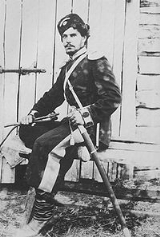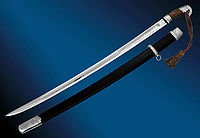
Shashka
Encyclopedia

Sabre
The sabre or saber is a kind of backsword that usually has a curved, single-edged blade and a rather large hand guard, covering the knuckles of the hand as well as the thumb and forefinger...
; a very sharp, single-edged, single-handed, and guardless
Hilt
The hilt of a sword is its handle, consisting of a guard,grip and pommel. The guard may contain a crossguard or quillons. A ricasso may also be present, but this is rarely the case...
sword
Sword
A sword is a bladed weapon used primarily for cutting or thrusting. The precise definition of the term varies with the historical epoch or the geographical region under consideration...
. In appearance, the shashka was midway between a full sabre and a straight sword. It had a slightly curved blade, and could be effective for both slashing and thrusting. The blade was either hollowed or fullered
Fuller (weapon)
A fuller is a rounded or beveled groove or slot in the flat side of a blade . A fuller is often used to lighten the blade, much in the way that an I-beam shape allows a given amount of strength to be achieved with less material...
. There was no guard, but a large, curved pommel. The hilt was frequently highly decorated. It was carried in a wooden scabbard
Scabbard
A scabbard is a sheath for holding a sword, knife, or other large blade. Scabbards have been made of many materials over the millennia, including leather, wood, and metals such as brass or steel.-Types of scabbards:...
that enclosed part of the hilt. It was worn with the cutting edge to the rear, opposite to the sabre.
History
The shashka originated among the mountain tribes of the CaucasusCaucasus
The Caucasus, also Caucas or Caucasia , is a geopolitical region at the border of Europe and Asia, and situated between the Black and the Caspian sea...
in the 12th or 13th century. Later it was used by most of the Russia
Russia
Russia or , officially known as both Russia and the Russian Federation , is a country in northern Eurasia. It is a federal semi-presidential republic, comprising 83 federal subjects...
n and Ukrainian
Ukraine
Ukraine is a country in Eastern Europe. It has an area of 603,628 km², making it the second largest contiguous country on the European continent, after Russia...
Cossacks. So there are two styles of shashka: the Caucasian shashka and the Cossack shashka.
It was a typically Adyghe
Adyghe people
The Adyghe or Adygs , also often known as Circassians or Cherkess, are in origin a North Caucasian ethnic groupwho were displaced in the course of the Russian conquest of the Caucasus in the 19th century, especially after the Russian–Circassian War of 1862.Adyghe people mostly speak Adyghe and most...
an (Circassian
Adyghe language
Adyghe language , also known as West Circassian , is one of the two official languages of the Republic of Adygea in the Russian Federation, the other being Russian. It is spoken by various tribes of the Adyghe people: Abzekh, Adamey, Bzhedugh; Hatukuay, Kemirgoy, Makhosh; Natekuay, Shapsigh; Zhane,...
) form of sabre, longer than the Cossack type, in fact the word shashka came from the Adyghe word "Shashkwa" means "long knife". It gradually replaced the sabre in all cavalry units except hussar
Hussar
Hussar refers to a number of types of light cavalry which originated in Hungary in the 14th century, tracing its roots from Serbian medieval cavalry tradition, brought to Hungary in the course of the Serb migrations, which began in the late 14th century....
s during the 19th century. Russian troops, having encountered it during their conquest of the Caucasus
Caucasian War
The Caucasian War of 1817–1864, also known as the Russian conquest of the Caucasus was an invasion of the Caucasus by the Russian Empire which ended with the annexation of the areas of the North Caucasus to Russia...
, preferred it to their issue sabres. It was adopted first by the Russian Caucasian Corps in the 1830s. In 1882, when the cavalry was reorganized, the regular dragoon
Dragoon
The word dragoon originally meant mounted infantry, who were trained in horse riding as well as infantry fighting skills. However, usage altered over time and during the 18th century, dragoons evolved into conventional light cavalry units and personnel...
s were armed with the shashka. Cossacks had received this type of sword earlier. Several forms of shashka were carried by Soviet
Soviet Union
The Soviet Union , officially the Union of Soviet Socialist Republics , was a constitutionally socialist state that existed in Eurasia between 1922 and 1991....
cavalry into the Second World War
World War II
World War II, or the Second World War , was a global conflict lasting from 1939 to 1945, involving most of the world's nations—including all of the great powers—eventually forming two opposing military alliances: the Allies and the Axis...
.
Construction

The handle of the sabre was crafted so as to have a built-in pommel and possibly a small guard, which usually extended to only one side of the hilt. Like most medieval and then imperial Russian
Russian Empire
The Russian Empire was a state that existed from 1721 until the Russian Revolution of 1917. It was the successor to the Tsardom of Russia and the predecessor of the Soviet Union...
weaponry of the time, often the shashka and its scabbard were very ornately decorated, with gold and silver engravings, embedded gems and stones placed into, and figures carved out of or into, the hilts. The blade of the sabre was generally double or triple-fullered, and due to its greater width than that of the European sabre, and its unique styles of tempering, it was much stronger too, able to deal damage to light body armor.
The shashka has the feel of a European sabre and was notable for its sharpness. There has been film footage of Tsar
Tsar
Tsar is a title used to designate certain European Slavic monarchs or supreme rulers. As a system of government in the Tsardom of Russia and Russian Empire, it is known as Tsarist autocracy, or Tsarism...
Nicholas II (1868–1918) using a Circassian sabre in an overhead twirling motion to horizontally cut pieces from a wooden pole.

